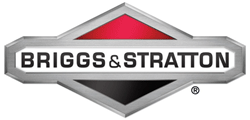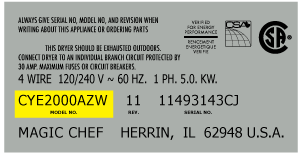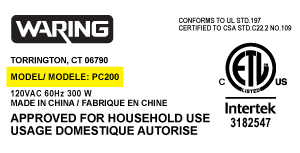31271-2 General Electric Refrigerator - Instructions
Keep searches simple. Use keywords, e.g. "leaking", "pump", "broken" or "fit".
Smelled burning plastic
I removed the cardboard cover from the back of the fridge. I was not sure where to begin then the compressor kicked on and a flame came from the bottom of relay that mounts to compressor, so i unplugged fridge and let cool .I removed part that burned and looked on this site to identify what it is. The part has been updated to a new design which is now a white plastic. I also replaced run capacitor .Put the new parts on and it was back to working .The sleeve that comes with the new run capacitor didn't fit under the lock wire clip so i left off.
Parts Used:
-
JOHN from PERKINSTON, MS
-
Difficulty Level:Really Easy
-
Total Repair Time:Less than 15 mins
-
Tools:Screw drivers
3 of 4 people
found this instruction helpful.
Was this instruction helpful to you?
Thank you for voting!
lights blown out
-
Gerald from WINTERVILLE, GA
-
Difficulty Level:Very Easy
-
Total Repair Time:Less than 15 mins
6 of 14 people
found this instruction helpful.
Was this instruction helpful to you?
Thank you for voting!
The light inside the oven had burned out
0. As a safety precaution, unplug the range or hit the relevant fuse breaker before you start. You might also want to grab a flashlight. Definitely do not try to do this while the oven is hot.
1. Pinch the wire over the light bulb cap to remove it. This is inside the oven at the back.
2. Pop off the hemispherical glass cap.
3. Unscrew the old light bulb, and screw the new light bulb in its place.
4. Put the cap back.
5. Secure the cap by putting the wire back in its slots on the cap.
No tools needed, the cap is just held in place with pressure from the wire.
1. Pinch the wire over the light bulb cap to remove it. This is inside the oven at the back.
2. Pop off the hemispherical glass cap.
3. Unscrew the old light bulb, and screw the new light bulb in its place.
4. Put the cap back.
5. Secure the cap by putting the wire back in its slots on the cap.
No tools needed, the cap is just held in place with pressure from the wire.
Parts Used:
-
Catherine from SEATTLE, WA
-
Difficulty Level:Very Easy
-
Total Repair Time:Less than 15 mins
3 of 5 people
found this instruction helpful.
Was this instruction helpful to you?
Thank you for voting!
Light burnt out.
Turned the wire protector to the side. Turned out the old bulb and replaced it with the new. Turned the wire protector back in place and I'm like new.
Parts Used:
-
Roscoe G from ROCHESTER, NY
-
Difficulty Level:Very Easy
-
Total Repair Time:Less than 15 mins
2 of 2 people
found this instruction helpful.
Was this instruction helpful to you?
Thank you for voting!
Loud motor noise emanating from inside the refrigerator (not the compressor or external fan).
My GE GDS18SBPBLSS is now 21 years old (they do not make them like they used to) so I took extra time to not break any of the brittle old plastics. For this replacement you will only need a Phillips head screwdriver.
Parts list:
2 x PS284959 Fan Motor Grommet
1 x PS2359960 Evaporator Fan Motor Assembly
• The first thing you want to do is to unplug the unit refrigerator to prevent any shorts or the fan from starting while you are handling it.
• The evaporator motor is in the refrigerator section, so leave the freezer door shut to preserve the temperature.
• Open the refrigerator door as much as possible and take out the two vegetable/fruit drawers. If your door is right next to a wall and you cannot open it more than 90 degrees, take the drawer furthest from the door hinge first. Then take out the remaining drawer and gently shimmy the center plastic rail guide to allow you to take it out diagonally.
• The front lip of the floor of the refrigerator is clipped in, so pull the plastic trim forward to remove it. If it does not move, lift the center of the plastic trim piece in front of the screw a bit to convince it loose, but it prying it upwards is not advisable because the ends are under the side walls.
• Once the trim piece is removed, remove the Phillips head screw.
• Pull the plastic floor of the refrigerator towards the front and then up to remove it.
• A large foam block secured down with tape needs to be removed next. Once the tape is loosened, lift the foam out carefully with vapor barrier attached under it. Watch for the two foam pieces at the back wall on each side. If they fall off and drop, find them in the freezer later.
• The fan assembly and bracket will be in view, and my suggestion is to take a photo. This way, you know how it should look when it comes time to reassemble everything.
• To the left rear is a small foam block that is taped down. Removing that will reveal the connector clip for the fan motor’s power line that you squeeze the sides to disconnect. Pull the motor wire out of the foam guide.
• Lift the motor bracket assembly out – it is not attached to anything and sits on the foam block.
• Carefully pull the fan blade off by pulling it straight along the motor shaft.
• Undo the rear motor bracket by unscrewing the two Phillips head screws – the right rear motor bracket screw holds the wire guide in. When undone, take the guide off the wire.
• Once the rear bracket is removed, discard the two motor grommets and the motor.
• Put in the new motor with the new motor grommets into the bracket and screw in the left rear screw.
• Clip on the wire guide on to the new motor wiring and then finish mounting the motor with the right rear screw with the wire guide in place.
• Clean off the fan blade thoroughly before pressing into the shaft. Once on, spin the fan to see if it rotates smoothly and easily. Note: Avoid pressing the fan blade too far down as you do not want it to contact the grommet.
• Place the assembly back into the foam block – use the photo from before as a guide if needed.
• Route the motor cable through the foam groove and clip it into the power connector.
• Plug the refrigerator back in to see if the fan spins and to see that there are no issues. If there are no problems, unplug the unit again and continue the reassembly.
• Place the small foam block back into the rear left to cover the connector area.
• While making sure the vapor barrier is positioned correctly above the coils, put the foam block back into place.
• Clean the plastic floor of the refrigerator and then slide it into place, making sure the back and side are flush. Use the screw hole to align the floor properly and then screw the Phillips head screw back in.
• Clean the front trim piece and then slide it back into place.
• Put the drawers back in.
• Plug the refrigerator back in and leave the door closed for a while so the unit cools the internal temperature back down.
Parts list:
2 x PS284959 Fan Motor Grommet
1 x PS2359960 Evaporator Fan Motor Assembly
• The first thing you want to do is to unplug the unit refrigerator to prevent any shorts or the fan from starting while you are handling it.
• The evaporator motor is in the refrigerator section, so leave the freezer door shut to preserve the temperature.
• Open the refrigerator door as much as possible and take out the two vegetable/fruit drawers. If your door is right next to a wall and you cannot open it more than 90 degrees, take the drawer furthest from the door hinge first. Then take out the remaining drawer and gently shimmy the center plastic rail guide to allow you to take it out diagonally.
• The front lip of the floor of the refrigerator is clipped in, so pull the plastic trim forward to remove it. If it does not move, lift the center of the plastic trim piece in front of the screw a bit to convince it loose, but it prying it upwards is not advisable because the ends are under the side walls.
• Once the trim piece is removed, remove the Phillips head screw.
• Pull the plastic floor of the refrigerator towards the front and then up to remove it.
• A large foam block secured down with tape needs to be removed next. Once the tape is loosened, lift the foam out carefully with vapor barrier attached under it. Watch for the two foam pieces at the back wall on each side. If they fall off and drop, find them in the freezer later.
• The fan assembly and bracket will be in view, and my suggestion is to take a photo. This way, you know how it should look when it comes time to reassemble everything.
• To the left rear is a small foam block that is taped down. Removing that will reveal the connector clip for the fan motor’s power line that you squeeze the sides to disconnect. Pull the motor wire out of the foam guide.
• Lift the motor bracket assembly out – it is not attached to anything and sits on the foam block.
• Carefully pull the fan blade off by pulling it straight along the motor shaft.
• Undo the rear motor bracket by unscrewing the two Phillips head screws – the right rear motor bracket screw holds the wire guide in. When undone, take the guide off the wire.
• Once the rear bracket is removed, discard the two motor grommets and the motor.
• Put in the new motor with the new motor grommets into the bracket and screw in the left rear screw.
• Clip on the wire guide on to the new motor wiring and then finish mounting the motor with the right rear screw with the wire guide in place.
• Clean off the fan blade thoroughly before pressing into the shaft. Once on, spin the fan to see if it rotates smoothly and easily. Note: Avoid pressing the fan blade too far down as you do not want it to contact the grommet.
• Place the assembly back into the foam block – use the photo from before as a guide if needed.
• Route the motor cable through the foam groove and clip it into the power connector.
• Plug the refrigerator back in to see if the fan spins and to see that there are no issues. If there are no problems, unplug the unit again and continue the reassembly.
• Place the small foam block back into the rear left to cover the connector area.
• While making sure the vapor barrier is positioned correctly above the coils, put the foam block back into place.
• Clean the plastic floor of the refrigerator and then slide it into place, making sure the back and side are flush. Use the screw hole to align the floor properly and then screw the Phillips head screw back in.
• Clean the front trim piece and then slide it back into place.
• Put the drawers back in.
• Plug the refrigerator back in and leave the door closed for a while so the unit cools the internal temperature back down.
Parts Used:
-
Chong from NEW YORK, NY
-
Difficulty Level:Easy
-
Total Repair Time:Less than 15 mins
-
Tools:Screw drivers
2 of 2 people
found this instruction helpful.
Was this instruction helpful to you?
Thank you for voting!
freezer stoped freezing
my freezer quit freezing, it would freeze for one day, thaw the next, so I went online, found PARTS SELECT, LOOKED UP MY MODEL #, come to find out it needed three parts to keep my freezer to freeze, first part was a thermistor a small PART took me longer to remove all the covers, and shelving, PULLED THE OLD OUT, CUT THE WIERS TO SIZE, AND REINSTALLED, IT WELL! THAT WASN'T ENOUGH THE FREEZER STILL DIDN'T FREEZE IT THOUT IT WAS A COOL WORMING OVEN, HAD TO INSTALL THE THERMISTOR I, SO I DID, TEN MIN, NOW I THOUGHT THAT WAS IT BECAUSE IT STAYED FROZEN FOR A WEAK, HAVE YOU EVER EATEN SOUPY ICE CREAM? SO BACK TO PARTS SELECT, THIS TIME I BOUGHT ONE MORE PT, THE RUN CAPACITOR, FIVE MIN, THAT/S ALL IT TOOK TO INSTALL. I DID NOT KNOW AT THE TIME YOU NEED THE THREE OF THEM TO RUN THE FREEZER ONE TO KEEP THE TEMP., ONE TO KEEP THE FAN RUNNING THE WAY IT SHOULD, AND THE THIRD TO MAKE SURE THE OTHER TWO KEEP RUNNING. NOW I CAN SET IT AT 4- 5 AND. FREEZE.
Parts Used:
-
paul from ENDICOTT, NY
-
Difficulty Level:Very Easy
-
Total Repair Time:15 - 30 mins
-
Tools:Pliers, Screw drivers
2 of 2 people
found this instruction helpful.
Was this instruction helpful to you?
Thank you for voting!
The Refridgerator and Freezer were not cooling.
Installing the part repaired the fridge and freezer immediately.
Parts Used:
-
Frank from VERO BEACH, FL
-
Difficulty Level:Really Easy
-
Total Repair Time:15 - 30 mins
-
Tools:Pliers, Screw drivers
2 of 2 people
found this instruction helpful.
Was this instruction helpful to you?
Thank you for voting!
broken shelf end caps- right side of 2 shelves.
After watching video I took off end shelf caps. It took close to 10 mins to replace them.
Parts Used:
-
William from PRESQUE ISLE, ME
-
Difficulty Level:Really Easy
-
Total Repair Time:Less than 15 mins
2 of 2 people
found this instruction helpful.
Was this instruction helpful to you?
Thank you for voting!
light wouldn't come out of socket
It just unpluged and the new one plugged in. Simple. The part was reasonable and arrived very quickly. It sure is nice to have a light in the frig again.
Parts Used:
-
Joyce from Tacoma, WA
-
Difficulty Level:Really Easy
-
Total Repair Time:Less than 15 mins
3 of 5 people
found this instruction helpful.
Was this instruction helpful to you?
Thank you for voting!
Fridge light dead even with new bulb
1- youtubed the potential diagnoses, 2- resourced and ordered parts, 3- removed old socket, installed new one :-)... My fridge is an older fridge and could've used a screwdriver for eyeglasses. Plug and play easy... YAY!
Parts Used:
-
marj from NEWBURY PARK, CA
-
Difficulty Level:Really Easy
-
Total Repair Time:15 - 30 mins
-
Tools:Screw drivers
1 person
found this instruction helpful.
Was this instruction helpful to you?
Thank you for voting!
My light in the refrigerator was going on and off.
I unplugged the refrigerator. Pressed the tab near the light bulb. Unplugged the socket and reconnected it.
Parts Used:
-
Nan from PURCELLVILLE, VA
-
Difficulty Level:Very Easy
-
Total Repair Time:Less than 15 mins
1 person
found this instruction helpful.
Was this instruction helpful to you?
Thank you for voting!
bulb out
I ordered the part, within two days we had received it. My husband put the part in and I really don't know what he used doing so. All I know is that the light works now and we don't have to use the flashlight. Thanks a lot.
Parts Used:
-
Kenneth from Rowe, VA
-
Difficulty Level:Really Easy
-
Total Repair Time:Less than 15 mins
1 person
found this instruction helpful.
Was this instruction helpful to you?
Thank you for voting!
Lights did not work, bulbs were good
Took out the light sockets, plugged in the new ones. I found the manual on line to find the part numbers. Parts select parts were perfect
Parts Used:
-
Donita from O FALLON, MO
-
Difficulty Level:Easy
-
Total Repair Time:Less than 15 mins
-
Tools:Screw drivers
1 person
found this instruction helpful.
Was this instruction helpful to you?
Thank you for voting!
Start relay burned
Unplug the refrigerator removed the condenser/ compressor cover back bottom on fridge, remove the relay from the compressor took off the two wires, replace with new relay
Parts Used:
-
Carlos from Copper Canyon, OK
-
Difficulty Level:Very Easy
-
Total Repair Time:15 - 30 mins
-
Tools:Screw drivers
1 person
found this instruction helpful.
Was this instruction helpful to you?
Thank you for voting!
water leaking from under dishwasher
Water was leaking from under the GE dishwasher, but once we pulled it out, had apparently been going on for a little while. Turning the water off to the dishwasher made it stop, so it was happening even when the unit was not running, potentially indicating somewhere early in the path of the water to and into the machine.
Indeed, inspecting the water inlet vale showed a slow leak. Getting the replacement part was fine, and it fit the electrical, water inlet (existing 90-degree water inlet elbow), and water outlet connections just fine - but the original machine screws that held on the original water inlet valve did not work. It took a little research to figure out the new type of screw required, which was apparently a 10/16 Type AB, which seemed to be a less common type of sheet metal screw (with a point), as opposed to the original flat-ended machine screws. So, after ordering those separately (which were a bit expensive), it went together fine.
A note on the water inlet valve part just indicating the the threading on those parts has changed over time, so potentially ordering the screws to attach it might be worthwhile, would be good information to add about the water inlet valve.
Indeed, inspecting the water inlet vale showed a slow leak. Getting the replacement part was fine, and it fit the electrical, water inlet (existing 90-degree water inlet elbow), and water outlet connections just fine - but the original machine screws that held on the original water inlet valve did not work. It took a little research to figure out the new type of screw required, which was apparently a 10/16 Type AB, which seemed to be a less common type of sheet metal screw (with a point), as opposed to the original flat-ended machine screws. So, after ordering those separately (which were a bit expensive), it went together fine.
A note on the water inlet valve part just indicating the the threading on those parts has changed over time, so potentially ordering the screws to attach it might be worthwhile, would be good information to add about the water inlet valve.
Parts Used:
-
Edward from E LONGMEADOW, MA
-
Difficulty Level:A Bit Difficult
-
Total Repair Time:30 - 60 mins
-
Tools:Pliers, Socket set, Wrench (Adjustable)
1 person
found this instruction helpful.
Was this instruction helpful to you?
Thank you for voting!
































